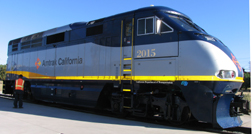In six days, Amtrak California’s Auburn to San Jose Capitol Corridor service marks 25 years of operation
Amtrak Capitol Corridor trains hit the rails running, as it were, on Dec. 12, 1991. Such marked the first time since 1974 in California that a “new” regional Amtrak passenger-rail service was established – the regional San Joaquin trains getting their start that same year in March. When begun, the state-supported and Amtrak-operated Capitols provided a sorely needed service between Sacramento and San Jose and proved to be just what the doctor ordered. Today, trains operate daily between those two metropolises, a 168-mile distance. Just a handful of the roughly three-dozen daily runs extend to Roseville and Auburn to Sacramento’s northeast.
On Nov. 14, 2003 a distribution/document developed by the Capitol Corridor Joint Powers Authority (the governing body overseeing the Capitol Corridor service) was presented to the San Joaquin Valley Rail Committee during one of its meetings, that day in the Golden State in the city of Hanford. Included in that correspondence was information that, after five years under CCJPA oversight, revealed Capitol Corridor ridership had reached an impressive 1.14 million riders annually and revenue was a healthy $11.55 million, at that time with 24 daily trains running. This compares with 8 daily trips in 1998 prior to CCJPA control first going into effect, resulting in then yearly ridership and revenue figures of 463,000 riders and $6.25 million, respectively. To say that growth under CCJPA administration has been phenomenal would be to state the obvious. According to information on Wikipedia, annual ridership in 2015 was 1,474,873.
What this means is that as many as 1,474,873 motor vehicle trips weren’t made. Most likely the number is considerably less, but still.

Those were the ’90s. At the 21st century’s dawning, on the other hand, much advancement had occurred technology-wise under the locomotive hood, as it were. Locomotive editor Greg McDonnell in “The New Dawn” (Editor’s Notebook) wrote: “Locomotive emissions standards – smoke abatement laws by another name – are again a hot ticket.”1
“Contemporary locomotives are leaner, greener, and meaner,”2 affirmed McDonnell. For locomotives pulling/pushing Amtrak “California” trains, it was the same.
In the spirit of modernization, Amtrak California’s F59PHI locomotives underwent an upgrading program beginning in 2009 which would result in far fewer emissions of oxides of nitrogen and fine particulate matter emanating from the locomotive’s prime mover exhaust stacks.
In the California Environmental Protection Agency Air Resources Board (ARB) news release “Amtrak California Repowers Toward a Greener Future: Introduction of New Locomotive Helps Reduce Caltrans’ Carbon Footprint,” on July 22, 2009, the ARB explained: “Locomotives have very large engines and are a major source of emissions of both Oxides of Nitrogen (NOx), a leading precursor to the formation of ozone and Diesel Particulate Matter (PM), a toxic air contaminant known to cause cancer and aggravate various respiratory diseases. Because the Capitol Corridor and San Joaquin routes pass through both the SMAQMD [Sacramento Metropolitan Air Quality Management District] and BAAQMD [San Francisco Bay Area Air Quality Management District] air districts, both air districts felt that a program to reduce emissions from these engines would be very valuable.”
Moreover, the ARB in the release wrote: “The first Caltrans locomotive to be upgraded is a Model F59PHI originally built by Electro-Motive Diesel in October 2001. EMD has installed a 710ECO™ Repower upgrade package with the latest microprocessor-controlled locomotive engine technology for lower emissions, increased fuel economy, greater reliability and predictable maintenance costs. The newly upgraded locomotive will now achieve EPA Tier 2 emissions performance – two levels cleaner than required for this model.”
And added: “Amtrak California is operating fifteen of the F59PHI locomotives and the goal is to convert the entire fleet to this new cleaner performance level, eventually reducing operating emissions by nearly 50 percent.” The locomotive that received the upgrade was due to have begun operating on the Capitol Corridor route between the Bay Area and Sacramento, according to the ARB in the release.
It isn’t just this. The switch by motorists from motor vehicles to these trains further contributes to cleaner air in the territory where Capitols service is offered.
What allowed the establishment of the Capitol Corridor service initially was passage in 1990 of two state propositions, namely Propositions 108 and 116, thus sparking a modern day rail renaissance in the Golden State, the likes of which had not been seen in decades.
The Capitol Corridor service has withstood the test of time, now a seasoned veteran marking up 25 years of dedicated service.
Though not without its difficult moments (call them growing pains if you so prefer) the Capitols soldier on, and quite proudly at that.
Notes
- Greg McDonnell, “The New Dawn” (Editor’s Notebook), Locomotive (Trains Special Edition No. 1-2007), p. 7
- Ibid
Department of corrections: It was originally reported that Capitol Corridor trains operate through both the “SCAQMD [South Coast Air Quality Management District] and BAAQMD [San Francisco Bay Area Air Quality Management District] air districts, …” The article has since been updated and now includes the correct information.
Image above: California Environmental Protection Agency Air Resources Board
Published by Alan Kandel
Why don’t you include links so we can post the entire article to social media?
Great article! Air quality is so important. It’s great to see that companies are trying harder to remedy poor air quality situations. Thanks for sharing!
and how many people remember that a “consulting firm” recommended that the Capitol Corridor and San Joaquin train service be eliminated? (back in the early/mid ’90s)
Like I said to a friend of mine today: California has done a really praiseworthy job with state-supported passenger train services.